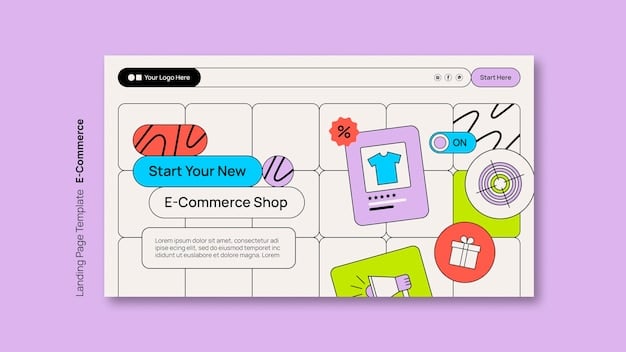Boost E-Commerce Sales: The Power of Personalization

Personalization in e-commerce tailors the shopping experience to individual customers, leveraging data to offer relevant product recommendations and targeted marketing, which can significantly enhance customer satisfaction and drive sales growth by up to 20%.
Want to increase your e-commerce sales? The secret might be in personalization in e-commerce: delivering tailored experiences that boost sales by 20%. Let’s dive into how you can make it happen!
Understanding the Fundamentals of E-Commerce Personalization
E-commerce personalization involves tailoring the online shopping experience to each individual customer’s preferences and behaviors. By leveraging data, businesses can create more relevant and engaging interactions, leading to increased sales and customer loyalty.
What is E-Commerce Personalization?
E-commerce personalization is the process of customizing a shopper’s experience on an online store. This can include personalized product recommendations, targeted marketing messages, and tailored content, all based on the shopper’s past behavior, preferences, and demographics.
The Importance of Data in Personalization
Data is the foundation of any successful personalization strategy. By collecting and analyzing data about customer behavior, businesses can gain valuable insights into what their customers want and need. This data can then be used to create more relevant and personalized experiences.
- 📈 Data collection is crucial for understanding customer behavior.
- 📊 Data analysis helps identify patterns and preferences.
- 🎯 Personalized experiences are driven by data-informed insights.
In conclusion, understanding the fundamentals of e-commerce personalization is essential for any online business looking to enhance customer engagement and drive sales growth. By leveraging data and tailoring the shopping experience, businesses can create more meaningful interactions with their customers.
Implementing Personalized Product Recommendations
Personalized product recommendations are a cornerstone of e-commerce personalization. By suggesting products that are relevant to individual shoppers, businesses can increase the likelihood of a purchase and improve the overall customer experience.
Types of Product Recommendations
There are several types of product recommendations that e-commerce businesses can use. These include recommendations based on past purchases, browsing history, items frequently viewed together, and trending products.
Best Practices for Product Recommendations
To ensure that product recommendations are effective, it’s important to follow best practices. This includes displaying recommendations prominently on product pages, using clear and concise language, and regularly updating recommendations based on customer behavior.
- ✨ Prominent placement of recommendations enhances visibility.
- 📝 Clear and concise language improves engagement.
- 🔄 Regular updates ensure relevance to customer needs.
In summary, implementing personalized product recommendations can significantly enhance the e-commerce experience. By understanding the different types of recommendations and following best practices, businesses can drive sales and improve customer satisfaction.
Leveraging Targeted Marketing Messages
Targeted marketing messages involve delivering personalized content to customers based on their unique characteristics. By tailoring marketing messages to individual shoppers, businesses can increase engagement, improve conversion rates, and foster stronger customer relationships.
Segmentation Strategies for Targeted Marketing
Segmentation is a key component of targeted marketing. By dividing customers into distinct segments based on demographics, behavior, and preferences, businesses can create marketing messages that resonate with each group.
Crafting Personalized Email Campaigns
Email marketing remains a powerful tool for e-commerce businesses. By personalizing email campaigns with relevant content and offers, businesses can increase open rates, click-through rates, and ultimately, sales.
- 📧 Relevant email content drives higher engagement rates.
- 🎁 Personalized offers increase the likelihood of conversion.
- 🤝 Stronger customer relationships are built through consistent, targeted communication.
In conclusion, leveraging targeted marketing messages is crucial for enhancing customer engagement and driving sales growth. By employing effective segmentation strategies and crafting personalized email campaigns, businesses can create more meaningful interactions with their customers.
Enhancing the User Experience Through Personalization
Personalization can significantly enhance the user experience on an e-commerce website. By tailoring the website layout, content, and navigation to individual preferences, businesses can create a more intuitive and engaging shopping experience.

Customizing Website Layout and Navigation
One way to enhance the user experience is by customizing the website layout and navigation. This can involve displaying frequently visited categories more prominently, highlighting relevant products, and tailoring the search results to individual preferences.
Personalized Content and Offers
In addition to customizing the website layout, businesses can also personalize the content and offers that are displayed to individual shoppers. This can involve displaying targeted promotions, highlighting relevant blog posts, and showcasing product reviews that are relevant to the shopper’s interests.
- 🌐 Customized website layouts improve user navigation.
- 🎁 Personalized offers increase conversion rates.
- 📰 Relevant content keeps shoppers engaged and informed.
In summary, enhancing the user experience through personalization is essential for creating a loyal customer base and driving sales growth. By customizing the website layout, content, and navigation, businesses can create a more engaging and intuitive shopping experience.
Measuring the Impact of Personalization Efforts
Measuring the impact of personalization efforts is crucial for determining the effectiveness of a personalization strategy. By tracking key metrics, businesses can gain insights into what’s working and what’s not, allowing them to optimize their personalization strategy over time.
Key Metrics to Track
There are several key metrics that e-commerce businesses should track to measure the impact of personalization efforts. These include conversion rates, click-through rates, average order value, and customer lifetime value.
A/B Testing for Personalization Strategies
A/B testing is a valuable tool for optimizing personalization strategies. By testing different personalization approaches, businesses can determine which strategies are most effective at driving sales and improving the customer experience.
- 📈 Conversion rates indicate the success of personalized offers.
- 🖱️ Click-through rates measure engagement with targeted content.
- 💰 Average order value reflects the impact of product recommendations.
In conclusion, measuring the impact of personalization efforts is essential for optimizing a personalization strategy and driving sales growth. By tracking key metrics and conducting A/B testing, businesses can ensure that their personalization efforts are delivering the desired results.
Future Trends in E-Commerce Personalization
The field of e-commerce personalization is constantly evolving, with new technologies and approaches emerging all the time. By staying abreast of future trends, businesses can position themselves for success in the years to come.
Artificial Intelligence and Machine Learning
Artificial intelligence (AI) and machine learning (ML) are playing an increasingly important role in e-commerce personalization. By leveraging AI and ML, businesses can analyze vast amounts of data and create more sophisticated and accurate personalization strategies.
Voice Commerce and Personalization
Voice commerce is another emerging trend that is poised to transform the e-commerce landscape. As more consumers adopt voice-activated devices, businesses will need to adapt their personalization strategies to accommodate voice-based shopping experiences.
- 🤖 AI and ML enable more sophisticated personalization strategies.
- 🗣️ Voice commerce demands new approaches to personalization.
- 👓 Augmented reality offers immersive personalized shopping experiences.
In summary, staying ahead of future trends is crucial for success in the e-commerce landscape. By embracing AI, ML, voice commerce, and augmented reality, businesses can create more personalized and engaging shopping experiences for their customers, leading to increased sales and loyalty.
| Key Point | Brief Description |
|---|---|
| ✨ Personalized Recommendations | Suggesting products based on customer’s past behavior. |
| 📧 Targeted Marketing | Delivering personalized content to specific customer segments. |
| 🌐 Enhanced User Experience | Customizing the website layout and content for each user. |
| 🤖 AI-Driven Personalization | Using AI to analyze data and create sophisticated personalization strategies. |
FAQ Section
▼
E-commerce personalization involves tailoring the online shopping experience to individual customer preferences and behaviors. This includes personalized product recommendations, targeted marketing messages, and customized website layouts.
▼
Personalization is crucial because it enhances customer engagement, improves conversion rates, and fosters stronger customer relationships. By delivering relevant and tailored experiences, businesses can drive sales and increase customer loyalty.
▼
You can implement personalized product recommendations by leveraging data about customer behavior, such as past purchases, browsing history, and items frequently viewed together. Use this data to suggest relevant products to each shopper.
▼
Key metrics to track include conversion rates, click-through rates, average order value, and customer lifetime value. These metrics provide insights into the effectiveness of your personalization strategy.
▼
Future trends include the use of artificial intelligence (AI) and machine learning (ML) for more sophisticated personalization, voice commerce for voice-based shopping experiences, and augmented reality for immersive shopping experiences.
Conclusion
In conclusion, personalization in e-commerce: delivering tailored experiences that boost sales by 20% is not just a trend but a necessary strategy for success in today’s competitive online marketplace. By understanding the fundamentals, implementing effective strategies, and staying abreast of future trends, e-commerce businesses can create more engaging and rewarding experiences for their customers, leading to increased sales and long-term loyalty.





